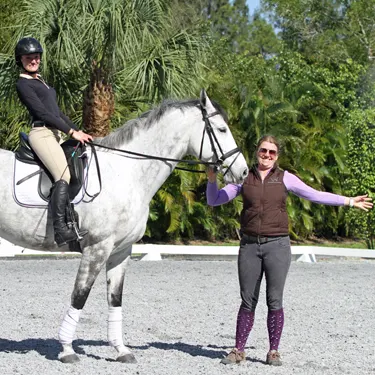No trainer has ever wondered what I’m thinking while I’m riding—a combination of my facial expression and posture is enough for my childhood trainer, Katie Lange-Lima, to tell if I’ve seen a distance, how long or short that distance is going to be, and if she should just close her eyes and pray to the hunter gods, asking for wings for my horse and margaritas to fall from the sky.
So I guess I really shouldn’t be surprised that when I went to take two different dressage lessons, one with Lauren Sprieser and the other with Ruth Hogan-Poulsen, the pictures spoke volumes about what happens when Harry the Hunter brain meets Sally the Dressage lady.
All variations of my expression, ranging from extreme awkward turtle (how do one’s back bones bend that way?!) to pure glee (I thought I might be pirouetteing; I was not) were just the visual smoke signals coming from my hunter brain as it desperately grappled for a foothold in this crazy foreign world of dressage.
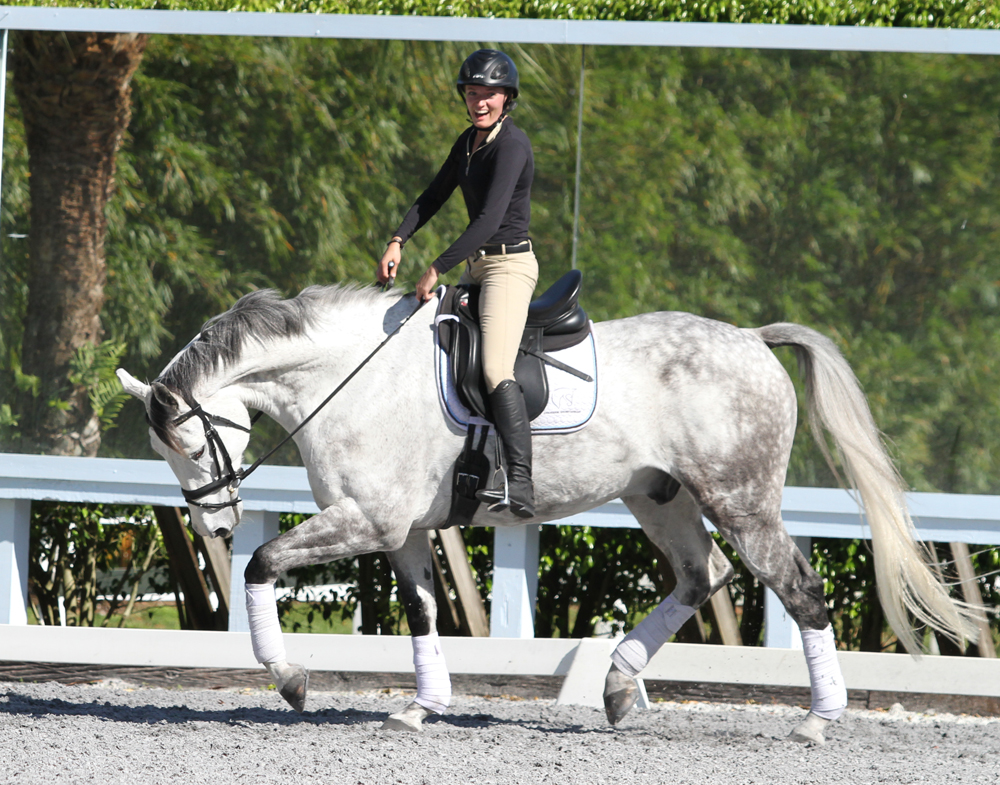
“So THIS is a trot!” is what that smile says. Photo by Ilana Cramer.
Compared to the other discipline adventures I’ve dipped a toe into (polo, vaulting, endurance, reining, eventing, driving, foxhunting, breezing a race horse), dressage may not seem to be the biggest leap from show huntering in the bunch. I mean, reining involved entirely different tack than I’ve ever ridden in, polo involved hitting a ball (which I was horrendous at), and vaulting was a beautiful exhibition of just how uncoordinated you can be and still manage to stay atop a cantering horse.
And really, in my mind, I have done dressage before. After all, what do trainers always tell you? Dressage means schooling the horse, and I school my horse all the time! We practice shoulder-in and haunches-in, leg yielding, turns on the haunches, and counter-cantering. While it may not be show worthy in the dressage world, I thought, “It’s not like you’ve NEVER done dressage. This will be fun, like an intense flat lesson!”
Wrong on so many levels that we’ll say every level. Flatting is really just the wrong word for riding a horse not-over-fences, because these dressage horses don’t flat, they bounce. They become these muscled balls of energy, just waiting in your hands and in your core for you to let them bound further out, or collect and bounce up.
And the rider’s position is nothing like what I do when I flat my horse. The stirrups are longer, your leg hangs differently because of it, and OH, the SHOULDERS. I am slouchy by hunter standards—I am positively the Hunchback of Notre Dame in dressage land. So come with me on a journey, as we explore what dressage does to Ann’s face when she is brazen enough to think it will just be “an intense flat lesson.”
The first lesson I had was with trainer Ruth Hogan-Poulsen at her farm in Loxahatchee, Fla. Fellow equine media member Sue Weakley was kind enough to let me borrow her Lusitano gelding, Uno, for the lesson, which would be an introduction to the basics of dressage and the language and terms used between dressage trainer and student.
Essentially the whole lesson took place at the trot and walk on a 20-meter circle around Ruth, and despite how simple that sounds for someone who has been riding since she was 8, it was nearly impossible for me to do correctly! I maybe had a couple strides per circle where I was both holding my body and leg correctly, AND I was getting a quality trot out of Uno. The other however many strides involved me huffing and puffing in the Florida heat, shoulders hunched and brow furrowed in concentration, as I tried to both sit correctly AND be effective.
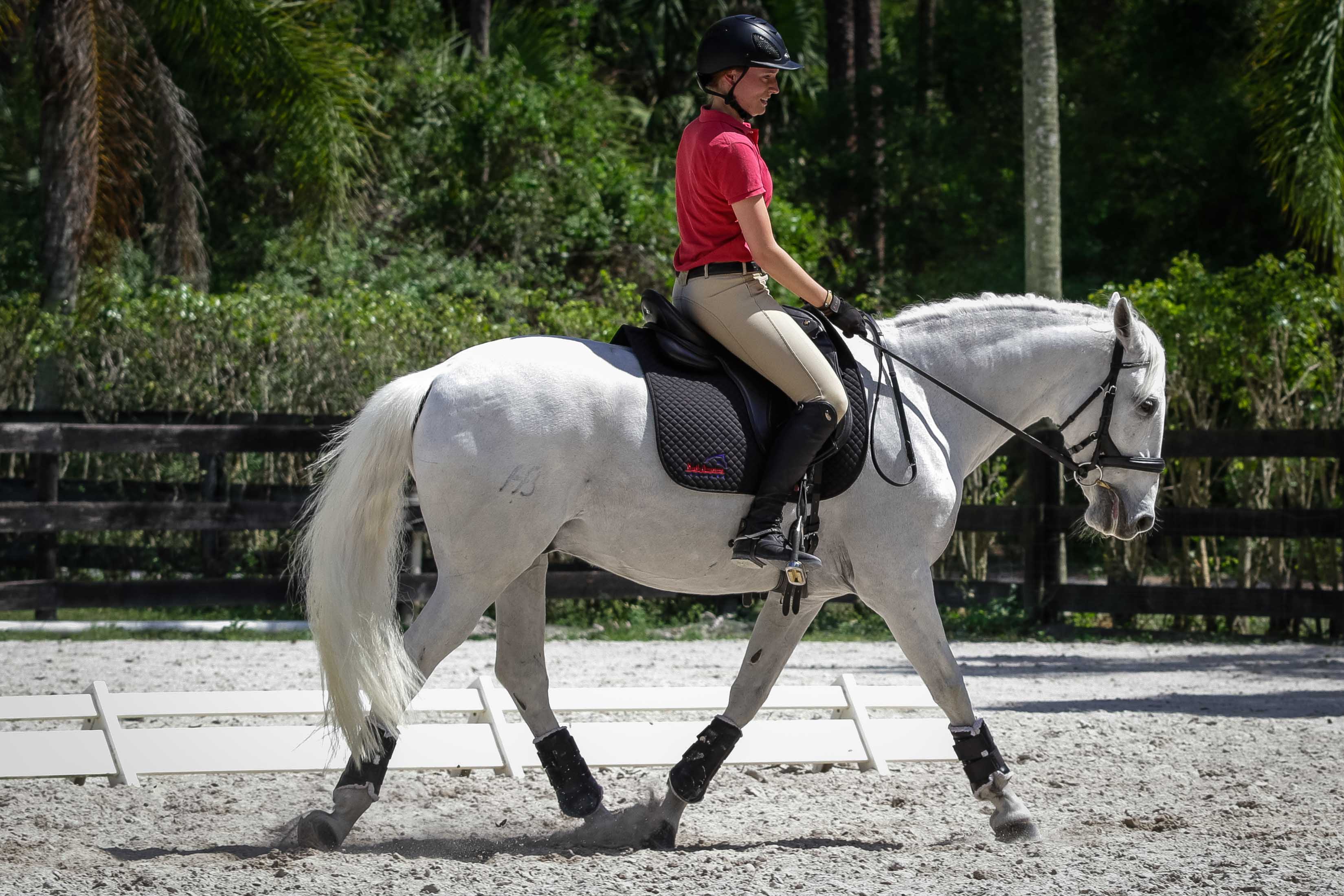
That’s me, trying to figure out how to put my body in the right places. Photo by Sue Weakley.
That lesson taught me that dressage is really in the details—the subtle differences certain cues make in your connection, your flexion, the slight difference in quality of trot that makes the point difference in your score when you go the show. Not surprising I struggled with it so much—details have never been my forte (ask my editors who have to deal with my, insane, overuse, of commas—and love of long dashes—every day).
The second lesson, with Lauren Sprieser, was less about learning the basics and more about seeing how much bungling Ann could do and still get movements out of a dressage horse. You probably know Lauren and the horses she was generous enough to put me on from her blog series on the Chronicle—I got to ride both Midgey and Dorian!
Lauren wanted to show me a piaffe in hand on Midgey before we got on Dorian for the rest of the lesson—very intuitive of Lauren to want to start with the movement that would require the least amount of effort from me. I just got to sit pretty while Midge danced along to Lauren’s cues! It was like the world’s most sophisticated pony ride, with me grinning like a kid at the fair while Midgey bounced up and down. What a natural I was at sitting and doing LITERALLY nothing! A-plus at nothing-doing, Glen Coco. You go.
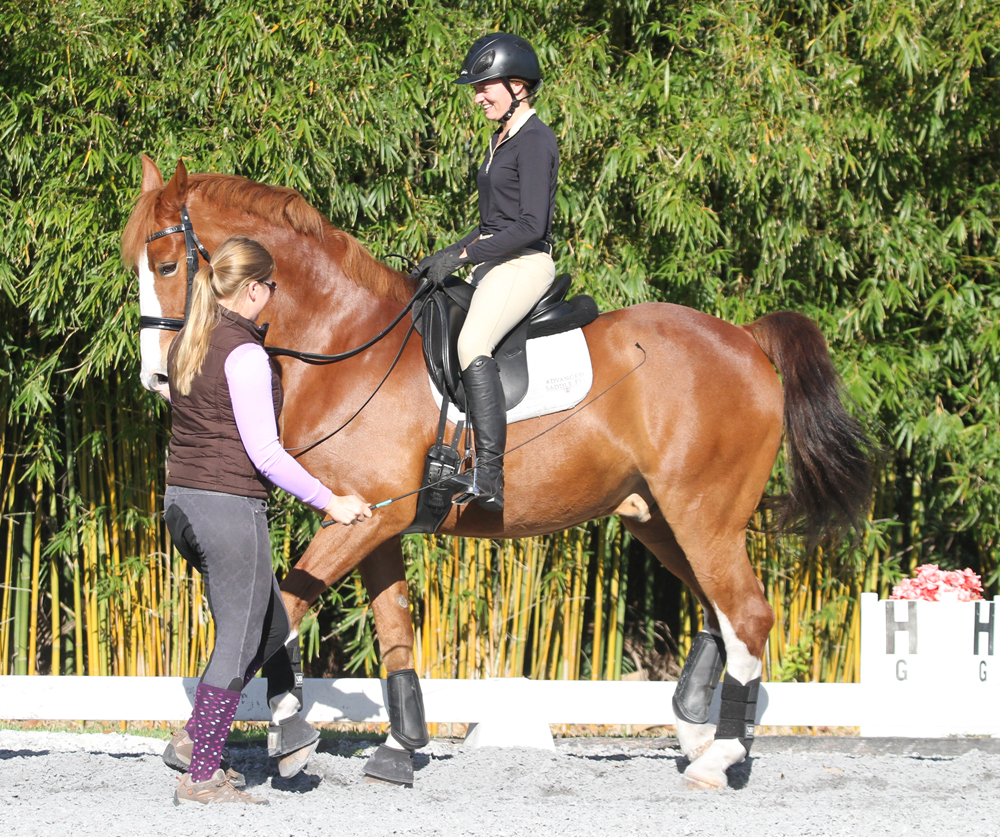
All the fun, none of the work! Piaffeing in hand on Midge. Photo by Ilana Cramer.
ADVERTISEMENT
My next victim was the most lovely gray horse, Dorian. I swung aboard him, and as we walked around Lauren gave me pointers on my position, directing me to sit up with my shoulders back, but not with an arc in my back, with a strong flat back, elbows in, abs flexed, so when we pushed Dorian into the bridle I would be holding him with my back. We’d be sitting the whole time too, no half-seat or two-point, so my stirrups were a little longer than I’m used to, so I could really (theoretically) wrap my leg around Dorian.
OK, I thought. I can do this, this is what I’m supposed to be doing on my hunter to some degree, any way. I’ve got this, right?
Nerrrrrrp, that’d be a negative. Turns out, there is a wrong way to sit, and I was stellar at it. Lauren kept directing me to sit, really sit, sit like I was trying to cover pockets on the back of my pants, sit more, MORE!
How one can be so bad at sitting, I had no idea until that lesson! Work on two-point? Sure, you can lean too far forward, dive with the shoulder, let your heels come up and back or kick your heels out in front of you. There are a million things to improve about that position, but SITTING? How in God’s name was I messing up sitting? This must be a career low for my riding life.

Cantering on Dorian. And not sitting enough. Photo by Ilana Cramer.
Turns out our dressage brethren are a little more sophisticated in their sitting than I was prepared for. Don’t get me wrong, obviously seat is important in hunters and jumpers, and I like to think I have a fairly decent seat at the canter and sitting trot when I hack my hunter, but it’s just never been the focus. There are fences to jump, lines to chip into, single oxers to superman fly over—I’ve got a lot on my mind, alright?! I left my seat at good enough and moved on, which apparently is not the way to go in dressage.
Once we had cantered and trotted around, and Lauren had at least established the position I should be striving for, we started working on some movements, starting at the canter. Lauren asked me to collect Dorian, which I did, and she said to collect him more, which I did, and then she said no that’s not even close to how far he can collect. “You’re going to feel like he’s going to break into a trot, but he won’t!” Lauren told me, and she was right. I wasn’t used to being able to adjust a horse to that slow of a canter, and slow only in speed—he was super active underneath me, just not fast.
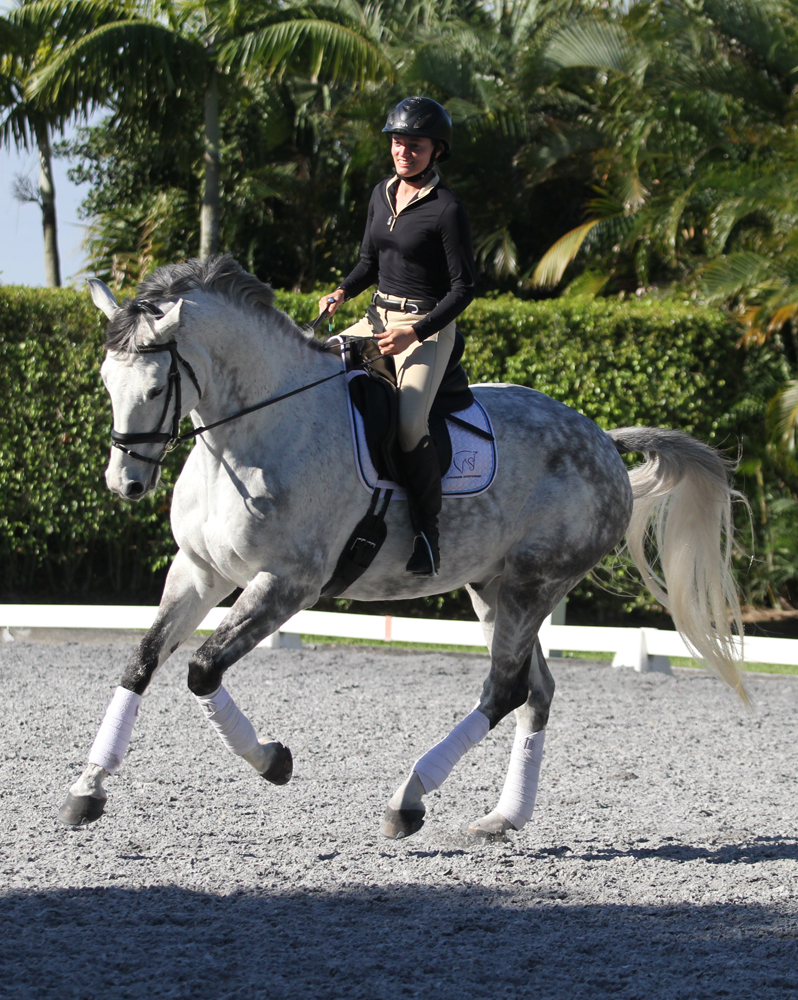
Cantering like I’ve never cantered before! Photo by Ilana Cramer.
Probably my favorite feeling from the lesson was when I cantered past Lauren on the rail, and she said, “When you get in front of me act like you’re going to collect so much he’ll canter in place,” and I did, and it was insane. It literally felt like he cantered almost in place, and not because he was hardly moving and was just petering out; it felt like he was war-horse, high knee-ed cantering, but with all the energy coming up, not out.
From there, I could see where the pirouette came from, and we tried our own little version of it. Lauren had me canter down the diagonal, as collected as I could (which I’m told was not even close to how much he can collect), and then to essentially do a really tight circle back on the diagonal, like a really tight 180, and canter back down the same diagonal in the opposite direction.
To be clear, we did not do a pirouette, nothing remotely close, but when we started to turn he took one canter stride rotating on his butt, and it felt SO cool. I was holding all this energy and power in my abs and hands, and it was just spinning around in this very organized manner.
I felt like a wizard! Or like an Avatar, directing earth and wind and fire and dressage magic with just the flick of a wrist (or rather, pull of the rein).
Wonderful photographer Ilana Cramer captured that exact moment we had our one-strided pretend pirouette—that is the face of a girl casting her first spell at Olivander’s dressage shop (and that, I promise, is the nerdiest Harry Potter reference this blog will be making).
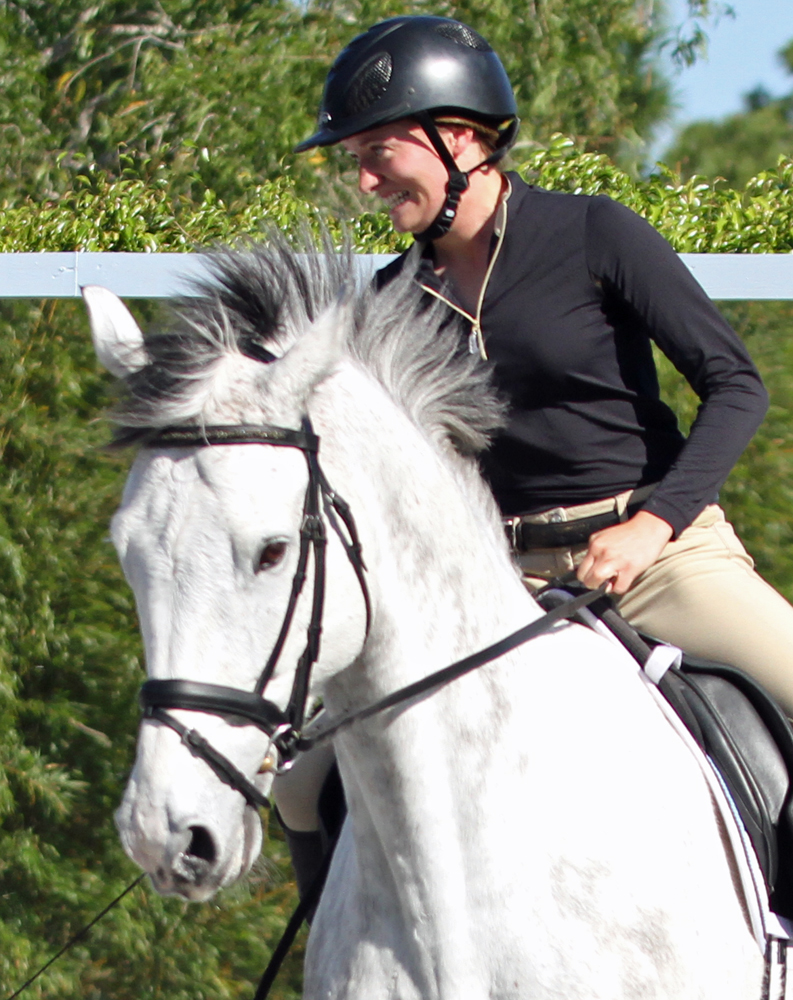
I am not a poker player. Photo by Ilana Cramer.
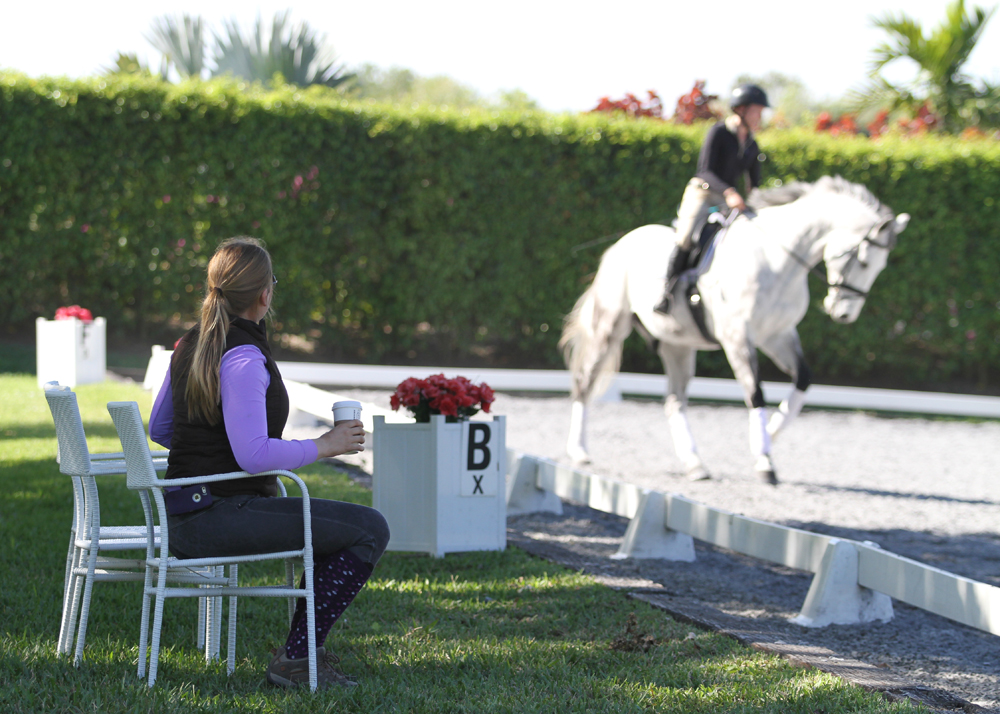
Lauren being very patient with me. Photo by Ilana Cramer.
ADVERTISEMENT
Dorian could not have been more tolerant of my Christopher Columbus style of dressage—tap dancing haphazardly across his highly programmed dressage buttons, once in a while hitting the right ones and letting something insanely cool happen, like cantering in place, or almost pirouetting, or half-passing.
And I was just splatter painting with the movements, trying this one and that one in no particular order, at no particular place in the ring—to take all those movements, and not only do them way better, but do them in a complicated pattern, at precise locations in the ring—that’s where the masters of the sport take my finger painted tour around the ring and turn it into the Mona Lisa. I have a lot more respect for how difficult that must be having taken these lessons, and I can feel how addicting that attention to details could be, how you could spend years mastering different movements.

May you continue your long and prosperous reign over the kingdom of details, Dressage Queens. Someone has to keep everything in line, and it certainly isn’t going to be a scatter-brained amateur like me. I’ll happily play court jester in your world, hoping a little bit of it will rub off and help me in my adventures through jumper land!
Ann Glavan was an editorial intern and now is an editorial staffer for The Chronicle of the Horse. Originally from Cedar Rapids, Iowa, Ann grew up competing at A circuit shows in the hunter and equitation divisions, first on her pony Is A Belle and more recently on her horse Happy Go Lucky. Ann interned for Phelps Media Group during the 2014 FTI Winter Equestrian Festival before joining the Chronicle team for the summer. She graduated from the University of Missouri after studying journalism and economics.
Our intrepid summer intern-then-hired-employee has been trying out all kinds of equestrian disciplines! Check out her other adventures…
Hunter/Jumper Intern Gets Hooked On Hunting
Hunter/Jumper Inter Spins And Chips Her Way To Reining Queen Status
Hunter/Jumper Intern Goes The Distance On 50-Mile Endurance Ride
Drive On! Hunter/Jumper Intern Tries Combined Driving, In Miniature!
At The Wire, It’s Hunter/Jumper Intern For The Win
Hunter/Jumper Intern Goes Cross-Country
Hunter/Jumper Intern Flips Out Over Vaulting

